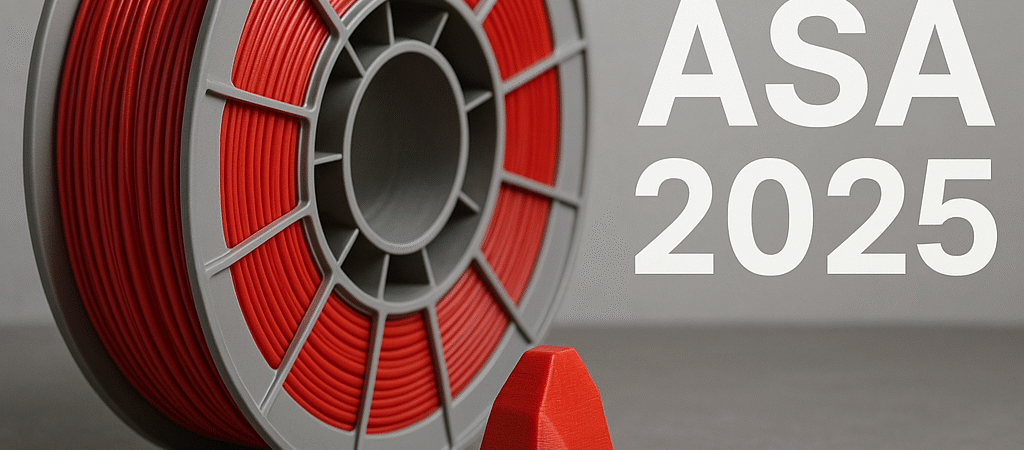3D printing has come a long way, and the materials we use are evolving right along with it. If you’re looking for something tough, weather-resistant, and easy enough to work with, ASA (Acrylonitrile Styrene Acrylate) is still one of the best options out there—especially for parts that need to survive outdoors. Since our last update, a lot has changed: better print methods, more eco-friendly options, and a growing market. Let’s break it all down.
What Exactly is ASA?
Think of ASA like ABS’s cooler, more outdoorsy cousin. It’s a durable thermoplastic with excellent UV, weather, and heat resistance—making it perfect for prints that will spend time outside. Over the years, ASA has carved out its own identity as more than just an ABS alternative. Today, it’s a go-to material for functional, long-lasting parts.
The ASA Market in 2025: Growing Fast
- ASA filament is projected to hit around $190 million in 2025, with expectations to surpass $500 million by 2030.
- What’s driving the boom? Rapid growth in prototyping, automotive tools, and industrial-grade applications.
- A big trend is recycled ASA, often made from e-waste. New recycling hubs—like the one that opened in Sydney in 2024—are making this option more accessible than ever.
What’s New in ASA Applications?
1. High-Speed Industrial Printing
New machines like the Raise3D Pro3 HS (launched in 2024) can print ASA faster and more accurately, opening the door to serious productivity gains.
2. Sustainability Wins
With the rise of recycled ASA from electronics, manufacturers are finally getting a tough, eco-friendly filament that doesn’t compromise performance.
3. Automotive & Aerospace
ASA is a favorite for prototypes, jigs, and fixtures—especially in hot and sunny environments where UV and heat resistance are critical.
4. Education & R&D
Universities and research labs love ASA for its balance of strength and ease of use. It’s reliable for classroom demonstrations and functional test models alike.
What’s Changed in ASA Performance?
- UV & Weather Resistance: Still one of ASA’s best traits. It shrugs off sun and rain like a champ.
- Surface Finish: Newer grades offer smoother finishes and less warping—a big win over 2024 versions.
- Heat Resistance: With a glass transition temp of around 93°C, ASA holds up well in hot conditions.
Why People Still Love ASA (2025 Edition)
- Tough Outdoors: Great for signs, enclosures, garden tools, and anything else that lives outside.
- Strong & Chemically Stable: Durable with high impact resistance—built to last.
- Greener Options: Recycled ASA is gaining traction and performs just as well.
- Finishing-Friendly: Easy to sand, paint, or vapor-smooth with acetone.
Drawbacks to Keep in Mind
- Printer Requirements: You’ll still need a hot bed (90–110 °C), hotend (230–260 °C), and ideally, an enclosure.
- Odor: ASA gives off fumes—so make sure you have good ventilation or filtration.
- Cost & Colors: It’s usually a bit pricier than ABS or PETG and still has fewer bright color choices.
- Warping: It’s improved, but brims, slower cooling, and enclosed printers are still key to success.
Pro Tips for Printing ASA in 2025
Printer Settings
- Nozzle: 240–260 °C
- Bed: 90–110 °C
- Enclosure: Strongly recommended
Cooling & Bed Adhesion
- Turn off or reduce cooling fans
- Use a brim or raft and apply glue stick or PVA for better grip
Post-Processing
- Sanding, vapor smoothing, painting—ASA handles it all well
Storage
- Store it dry and airtight; ASA can absorb moisture over time
Safety
- Keep your workspace ventilated, especially during long prints
Final Thoughts
ASA is still one of the most reliable and versatile filaments on the market in 2025. It’s UV-resistant, strong, and now more sustainable than ever, thanks to recycled variants. And with faster printers making it easier to use, there’s never been a better time to try it—especially if your projects need to handle the great outdoors.

